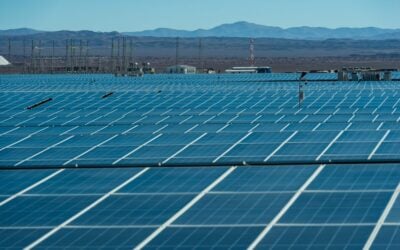A recently-commissioned large-scale storage plant integrating wind power in Germany – this particular one is used for local frequency regulation of the grid. Image: LG Chem.
The importance of balancing and improving electric grids is opening up pathways to the deployment of utility-scale energy storage, according to a Guest Blog from SMA Solar Technology, published this week on PV Tech Storage.
The blog, written by SMA senior vice-president for hybrid and energy storage integration Volker Wachenfeld and Dr. Alexsandra Sasa Bukvic-Schaefer, a senior expert in the same division, looks at how the applications for – and economics of – large-scale energy storage are changing. They suggest that the payback period for large-scale storage could be just over five years.
While the use of behind-the-meter energy storage has been widely seen as the best way to optimise solar PV production by households, the value of utility-scale energy storage is considered greatest when it offers benefits to the network as well as the individual user.
In looking at the different use cases for energy storage at grid level, the SMA duo found that, supplying operating reserve to the grid in Germany with batteries, expected to cost just under €800,000 (US$889,000) per megawatt to install, annual income of an estimated €130,000 (US$145,000) to €150,000 per megawatt installed could be made.
Try Premium for just $1
- Full premium access for the first month at only $1
- Converts to an annual rate after 30 days unless cancelled
- Cancel anytime during the trial period
Premium Benefits
- Expert industry analysis and interviews
- Digital access to PV Tech Power journal
- Exclusive event discounts
Or get the full Premium subscription right away
Or continue reading this article for free
With an expected system payback time of just over five years, this “creates interesting financial prospects”, the blog said, pointing out that previously, and in other markets, the payback time for such services has been too long. According to Wachenfeld and Bukvic-Schaeffer, municipal utilities appear to be keen to replace the provision of operating reserve using fossil fuels and battery-based proposals have been “generally met with a positive attitude”.
Wachenfeld and Bukvic-Schaeffer said the opportunity presented in this market should not be overestimated, but it did appear to demonstrate how the value of energy storage is starting to become recognised in key markets – pointing out that South Korea, where SMA recently won a contract to supply 200MW of inverters – is providing operating reserve perhaps “even more efficiently” than in Germany.
There are many advantages to using battery-based storage for providing operating reserve, the pair concluded. While barriers to guaranteeing “sustainable investment security” exist in many regions, especially at regulatory level, factors including simple scalability and ease of implementation for large-scale storage mean that as the needs of grids become more acute, these barriers are likely to be lifted.
Read Volker Wachenfeld and Dr. Alexsandra Sasa Bukvic-Schaefer’s blog for PV Tech Storage here.





